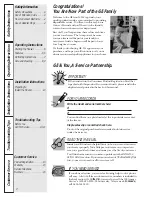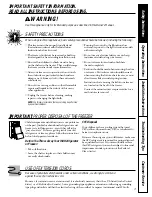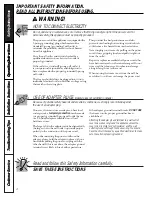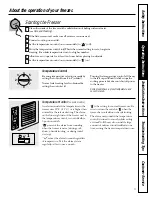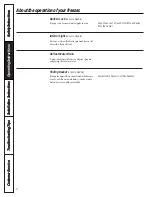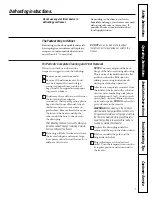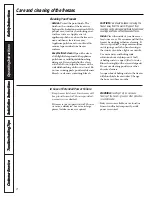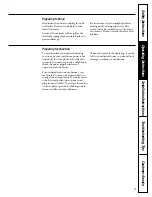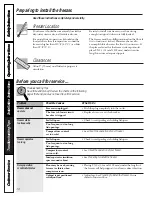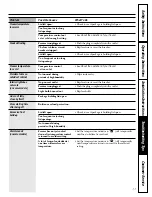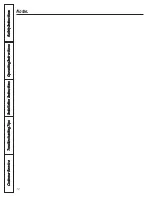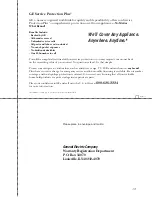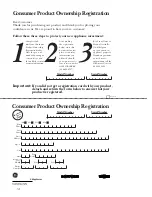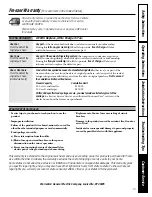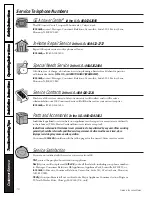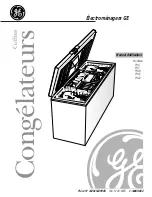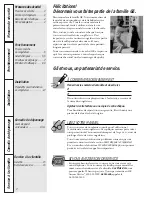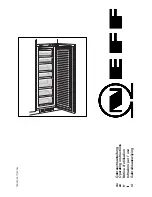
Customer Ser
vice
Tr
oubleshooting T
ips
Operating Instr
uctions
Safety Instr
uctions
Installation Instr
uctions
IMPORTANT SAFETY INFORMATION.
READ ALL INSTRUCTIONS BEFORE USING.
WARNING!
Use this appliance only for its intended purpose as described in this Owner’s Manual.
SAFETY PRECAUTIONS
When using electrical appliances, basic safety precautions should be followed, including the following:
■
■
This freezer must be properly installed and
located in accordance with the Installation
Instructions before it is used.
■
■
The freezer should not be recessed or built-in—
it is designed for free-standing installation only.
■
■
Do not allow children to climb, stand or hang
on the shelves in the freezer. They could damage
the freezer and seriously injure themselves.
■
■
After your freezer is in operation, do not touch
the cold surfaces, particularly when hands are
damp or wet. Skin may stick to these extremely
cold surfaces.
■
■
Do not store or use gasoline or other flammable
vapors and liquids in the vicinity of this or any
other appliance.
■
■
Unplug the freezer before cleaning, making
repairs or changing the light bulb.
NOTE:
We strongly recommend that any servicing be performed
by a qualified individual.
■
■
Turning the control to the
0
position does
not remove power to the light circuit on models
with interior light.
■
■
Do not use any electrical device or any sharp
instrument in defrosting your freezer.
■
■
Do not refreeze frozen foods which have
thawed completely.
■
■
Caution should be used when removing the door
of a freezer. Particular caution should be used
when removing the lid of a chest freezer, as most
chest freezer lids are under spring tension.
Instructions for removing the lid of your freezer
are located on the back of the freezer.
Contact the manufacturer’s representative for a
method of safe removal.
IMPORTANT:
PROPER DISPOSAL OF THE FREEZER
Child entrapment and suffocation are not problems
of the past. Junked or abandoned refrigerators and
freezers are still dangerous…even if they will sit for
“just a few days.” If you are getting rid of your old
refrigerator or freezer, please follow the instructions
below to help prevent accidents.
Before You Throw Away Your Old Refrigerator
or Freezer:
■
Take off the doors.
■
Leave the shelves in place so that children may
not easily climb inside.
CFC Disposal
Your old freezer has a cooling system that used
CFCs (chlorofluorocarbons). CFCs are believed to
harm stratospheric ozone.
If you are throwing away your old freezer, make sure
the CFC refrigerant is removed for proper disposal
by a qualified servicer. If you intentionally release
this CFC refrigerant you can be subject to fines and
imprisonment under provisions of the Federal
Clean Air Act.
USE OF EXTENSION CORDS
Because of potential safety hazards under certain conditions, we strongly recommend
against the use of an extension cord.
However, if you must use an extension cord, it is absolutely necessary that it be a UL-listed (in the United
States) or a CSA-listed (in Canada), 3-wire grounding type appliance extension cord having a grounding
type plug and outlet and that the electrical rating of the cord be 15 amperes (minimum) and 120 volts.
3


